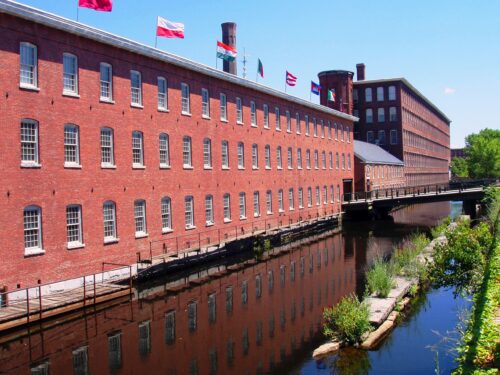Mill Building Soundproofing
Today, we see developers across the country invest in century old mill buildings and convert them into housing, commercial, or modern industrial spaces. In these types of conversions one challenge is always acoustics, sound transmission from space to space, the reverberation (echo) within a space, and the impact (foot fall) noise from upper levels. At DDS Acoustical Specialties we’ve come up with creative solutions and provided mill building soundproofing to developers and commercial customers.
These old, sturdy mill structures, some up to 200-years-old, were once staples of early American manufacturing. With their large spans, they are ideal for consumers seeking high ceilings, open floor plans and an industrial chic look. Today, practical considerations for converting these building reach far beyond aesthetics. Acoustic soundproofing and remediation require specialized attention and expertise to ready mill buildings for a new life.
Reducing Sound Transmission in Mill Buildings
Noise moving from one area to another is a big problem we’ve seen when it comes to mill building converting. You don’t want your residential or commercial tenants complaining that all they can hear is sounds from their next door or upstairs neighbors. Luckily there are acoustical products and solutions that can help.
The first steps to reducing sound transmission is to treat the floors and walls of a space with acoustical underlayment and barrier. Acoustic floor underlayment is applied beneath the finished floor and absorbs footfall noise that would typically be transmitted below. Acoustic barrier for walls is typically installed on wood framing and beneath sheetrock and significantly reduces sound transmission of adjacent rooms.
Love the look of the existing exposed brick or the vintage wood flooring? There are options to keep these features in-tact while treating the environment.
Improving Sound Absorption in Mill Buildings
Acoustical sound absorption products and application serve two primary purposes in the case of mill buildings. Firstly, it reduces echo and create a more desirable space for work, recreation, and living. Secondly, sound absorption helps reduce sound transmission since the more sound that is absorbed then the less there is to transmit to another space.
Sound Absorption can be achieved through proper application of acoustical products such as wall panels, ceiling panels, clouds or baffles. These products come in a variety of shapes, sizes, and colors to fit any aesthetic. At DDS Acoustical Specialties we will come up with a sound solution to any noise problem.
Soundproofing for Commercial Space in Mill Buildings
When redeveloping a mill building for commercial use there are acoustical aspects to consider. You don’t want businesses to be able to hear each other or their customers through walls or floors. In order to attract more tenants, you may also want to make sure business spaces have efficient sound absorption to reduce echo and improve speech intelligibility.
Soundproofing for Multi-family Housing in Mill Buildings
Soundproofing for multi-family housing in extremely important. According to the Department of Housing and Urban Development (HUD), multi-family developments are recommended to have walls with a Sound Transmission Coefficient (STC) 50. This can be achieved with proper application and design of walls with acoustical barrier products.
Soundproofing for Modern Industrial or Manufacturing in Mill Buildings
When talking about industrial and manufacturing coming into a mill building acoustics becomes even more important. Noisy machines from manufacturers may become an annoyance to neighboring businesses. Depending on how loud the machines in a facility are, we may recommend an acoustic enclosure to restrict the sound around a specific piece of machinery.
Benefits of Mill Building Soundproofing
-
Provide additional value to tenants
-
Reduce footfall noise from upper levels
-
Create an inviting environment for customers
-
Reduce noise created by heavy machinery


